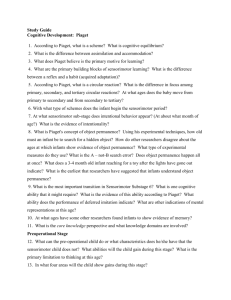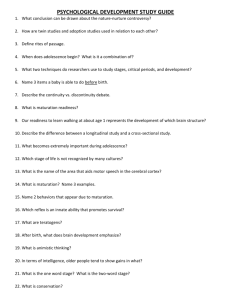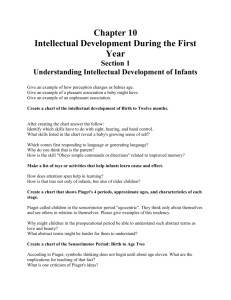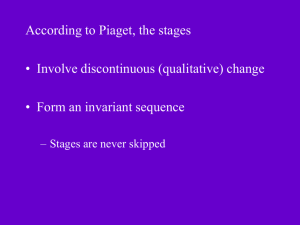Study Guide Chapter 5: Cognitive Growth Piaget: Overview
advertisement
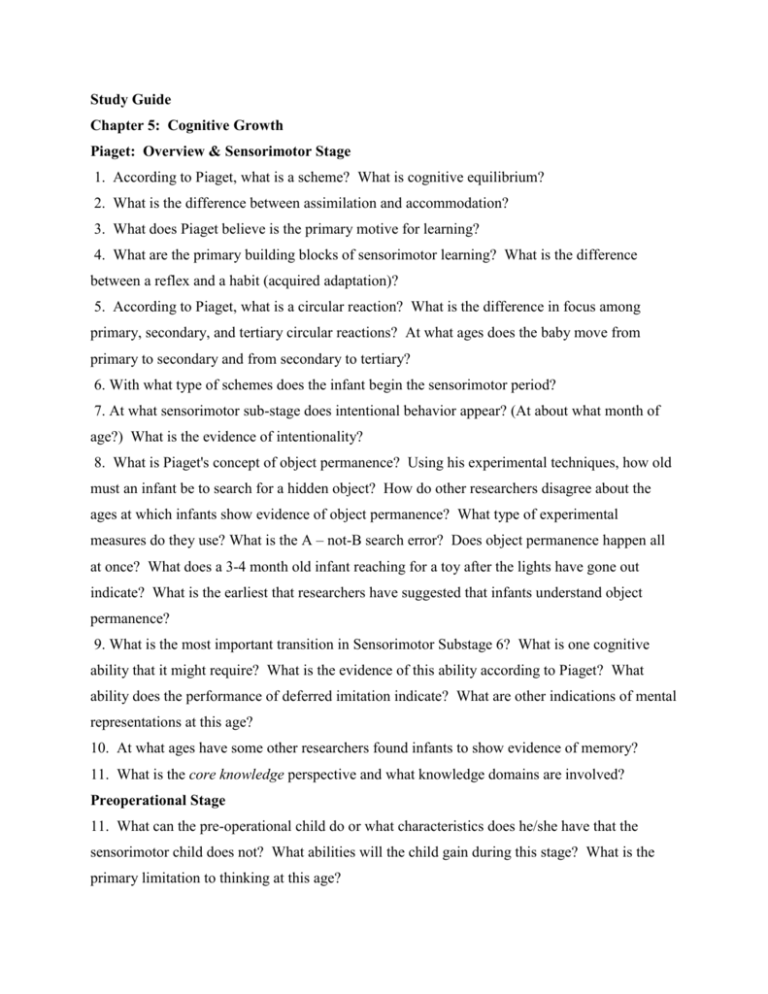
Study Guide Chapter 5: Cognitive Growth Piaget: Overview & Sensorimotor Stage 1. According to Piaget, what is a scheme? What is cognitive equilibrium? 2. What is the difference between assimilation and accommodation? 3. What does Piaget believe is the primary motive for learning? 4. What are the primary building blocks of sensorimotor learning? What is the difference between a reflex and a habit (acquired adaptation)? 5. According to Piaget, what is a circular reaction? What is the difference in focus among primary, secondary, and tertiary circular reactions? At what ages does the baby move from primary to secondary and from secondary to tertiary? 6. With what type of schemes does the infant begin the sensorimotor period? 7. At what sensorimotor sub-stage does intentional behavior appear? (At about what month of age?) What is the evidence of intentionality? 8. What is Piaget's concept of object permanence? Using his experimental techniques, how old must an infant be to search for a hidden object? How do other researchers disagree about the ages at which infants show evidence of object permanence? What type of experimental measures do they use? What is the A – not-B search error? Does object permanence happen all at once? What does a 3-4 month old infant reaching for a toy after the lights have gone out indicate? What is the earliest that researchers have suggested that infants understand object permanence? 9. What is the most important transition in Sensorimotor Substage 6? What is one cognitive ability that it might require? What is the evidence of this ability according to Piaget? What ability does the performance of deferred imitation indicate? What are other indications of mental representations at this age? 10. At what ages have some other researchers found infants to show evidence of memory? 11. What is the core knowledge perspective and what knowledge domains are involved? Preoperational Stage 11. What can the pre-operational child do or what characteristics does he/she have that the sensorimotor child does not? What abilities will the child gain during this stage? What is the primary limitation to thinking at this age? 12. In what four areas will the child show gains during this stage? 13. What are three characteristics of the symbolic function substage? Describe egocentrism, animism, and magical beliefs? 14. What question does the child often ask during the intuitive thought substage? What question can he not answer? 15. What is the primary task that Piaget found children could not do at this stage? What are the reasons why they cannot do this task? What are reversibility and centration? (Concrete operational children can do this task.) What are the four conservation tasks? 16. Piaget’s critics argued that children in this stage are not egocentric. What did they think was the problem that caused Piaget to conclude that they are? Why was the “three-mountain” experiment a problem? How well do 3-5 year olds fare on the “hide from the policeman” task? 17. What are the two summary criticisms of Piaget’s theory of young children’s (Stages 1 & 2) cognitive development? Concrete Operational Stage 20. What cognitive abilities or characteristics does the concrete operational child have that the pre-operational child did not? 21. What is he or she lacking that the formal operational thinker has? What is the limitation on this child’s ability to reason? 22. What task is still difficult for the child at this stage? What is de-centering, and what task does it enable the child to do? 23. What is horizontal decalage? Formal Operational Thought 24. What kind of thinking is included here that is not at any previous stage? What are the two major features or characteristics of formal operational thought? 25. Describe hypothetico-deductive reasoning and propositional thought? 26. What is Piaget’s pendulum problem, and what is it a test of? 24. What are some consequences of formal operational thought ? (Do not confuse these with the major characteristics.) What are some characteristics of the adolescent abstract thinker? 25. Describe adolescent egocentrism, the imaginary audience, and the personal fable including adolescent invincibility. 26. Do adults all reach formal operational thought? What evidence shows this? Who is most likely to achieve it and in what areas? 27. What did Piaget recommend for education? What is constructivist learning? Why are most of his recommendations not used? What assumption of his stage theory is ignored? Answers: Q 26. All normal adults reach the capacity for formal operational thought. The evidence for this is in the ability to train most people to use it when they are required to. Many people do not use it, and those who do tend to only use it in selected topic areas. The most likely to achieve it are college students and college-educated people in areas where they have experience and expertise. Q 27. Piaget recommended individualized instruction led by the child’s curiosity and interest. His recommendations are largely not used in U.S. public school systems because we are set up to do “lock-step” education where children in a class are all exposed to material as a group, ignoring readiness levels, interest, and time required to master the material. Piaget’s recommendations require too much in terms of resources and teacher/pupil ratios. Because of the lock-step approach, the assumption of developmental maturation (brain development/readiness) is also ignored because children differ in this, and the difference cannot be accommodated if they must all do the same work at the same time.
